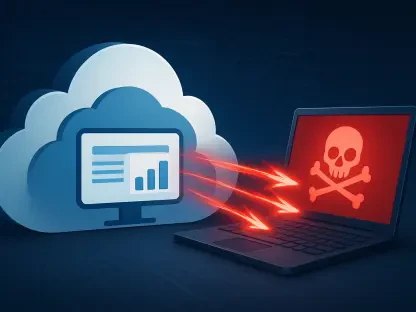In a world where enterprise software underpins the operations of countless organizations, a single overlooked flaw can unleash chaos, and this year, dozens of companies across the globe faced a chilling reality when a critical vulnerability in Oracle’s E-Business Suite (EBS) became the gateway for a devastating cyberattack. Linked to the infamous CL0P ransomware group, this breach exposed sensitive data and shook trust in systems meant to safeguard vital information. What made this attack so effective, and how did it slip through the cracks of even the most robust defenses?
The Stakes of a Silent Flaw
The significance of this incident cannot be overstated. Oracle EBS, a cornerstone for managing financials, supply chains, and customer data, is used by organizations ranging from small enterprises to global corporations. When a zero-day vulnerability—identified as CVE-2025-61882 with a staggering CVSS score of 9.8—came to light, it revealed a gaping hole that allowed remote code execution. This wasn’t just a minor glitch; it was a cybercriminal’s dream, enabling attackers to bypass traditional security measures and access high-value data with alarming ease. The fallout from this breach serves as a stark reminder of the cascading risks unpatched software poses in today’s interconnected digital landscape.
A Calculated Strike on Oracle’s Core
The attack unfolded with surgical precision, demonstrating the perpetrators’ deep understanding of Oracle EBS architecture. Suspicious activity targeting these systems was first detected in early July, escalating into a full-blown exploitation campaign by August 9. Hackers exploited the zero-day flaw to gain initial access, using it as a springboard for deeper intrusion. Their toolkit was sophisticated, combining techniques like Server-Side Request Forgery (SSRF) and authentication bypass to navigate through networks undetected. Dozens of organizations found themselves compromised, with attackers moving swiftly to secure their foothold.
Beyond the initial breach, the hackers deployed custom malware tailored for this operation. Payloads such as GOLDVEIN.JAVA, a downloader, and SAGEGIFT, a loader for Oracle WebLogic servers, were unleashed to facilitate data theft. These tools, alongside in-memory droppers like SAGELEAF, showcased meticulous planning and significant resources dedicated to pre-attack reconnaissance. The efficiency of targeting public-facing applications meant there was no need for lateral movement, allowing the attackers to focus on extracting sensitive information with minimal resistance.
Inside the Mind of a Cyber Extortionist
The technical prowess was only part of the equation; the extortion phase revealed a chilling psychological strategy. By late September, a high-volume email campaign targeted company executives, claiming that critical data had been stolen from their Oracle EBS systems. Sent from compromised third-party accounts likely purchased on underground forums, these messages demanded ransom payments to prevent public leaks. The delay in posting stolen data on leak sites—a tactic reminiscent of CL0P’s playbook—added pressure on victims to comply.
Cybersecurity experts have weighed in on the calculated nature of this campaign. A joint report from Google Threat Intelligence Group and Mandiant noted, “The blend of custom tools and layered exploitation techniques reflects a level of investment rarely seen in sporadic attacks.” This sophistication aligns with CL0P’s history of targeting enterprise software, though overlaps with FIN11-associated malware like GOLDVEIN complicate formal attribution. An industry observer added, “These threat actors operate with corporate-like precision, treating cybercrime as a business model built on fear and urgency.”
Patterns of a Persistent Threat
CL0P’s shadow looms large over this breach, given their track record of exploiting zero-day flaws in platforms like Progress MOVEit MFT. Active for several years, the group has honed a strategy of mass exploitation followed by relentless extortion. This latest incident mirrors their approach, with branded emails and delayed data leaks designed to maximize payouts. The potential connection to FIN11, another financially motivated actor, suggests a collaborative ecosystem where tools and tactics are shared among cybercrime networks.
What sets this attack apart is its focus on efficiency. By zeroing in on public-facing applications, the hackers bypassed the need for prolonged network traversal, streamlining their data exfiltration process. This trend of targeting widely used enterprise software is becoming a hallmark of modern cybercrime, as it offers a high return on investment for relatively low effort. With dozens of organizations impacted, the scale of this breach underscores the urgent need for heightened vigilance across industries.
Fortifying Defenses Against the Unseen
In response to this crisis, actionable steps are essential for organizations aiming to shield themselves from similar threats. Patching remains paramount—Oracle has released fixes for CVE-2025-61882, and applying updates without delay is critical. Subscribing to vendor alerts ensures timely awareness of emerging vulnerabilities. Additionally, limiting the exposure of enterprise systems to the internet through robust firewalls and access controls can significantly reduce the attack surface.
Beyond technical measures, preparation for extortion attempts is vital. Training staff to identify suspicious communications, especially emails targeting executives, can prevent hasty decisions under pressure. Implementing intrusion detection systems to monitor for unusual activity and conducting regular vulnerability assessments are also key to staying ahead of threats. Engaging third-party security experts for in-depth audits can uncover hidden weaknesses before they are exploited, offering a proactive layer of defense.
Reflecting on a Wake-Up Call
Looking back, the Oracle EBS breach stood as a defining moment that exposed the fragility of enterprise software under the weight of sophisticated cyber threats. It highlighted how even trusted systems could become liabilities when flaws went unaddressed. The incident also shed light on the evolving nature of cyber extortion, where technical exploits paired with psychological tactics created a formidable challenge for victims.
Moving forward, organizations must prioritize a culture of cybersecurity that emphasizes rapid response and continuous improvement. Investing in advanced monitoring tools and fostering collaboration between IT teams and leadership can build resilience against future attacks. As the digital landscape continues to shift, staying one step ahead of groups like CL0P demands not just reaction, but anticipation—turning lessons from this breach into a blueprint for stronger, more secure systems.









